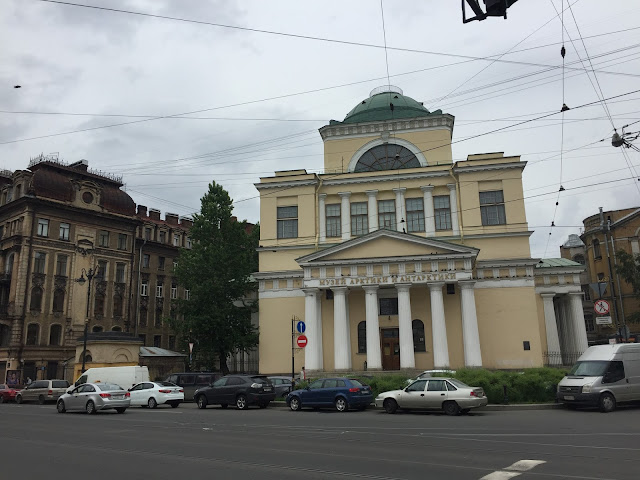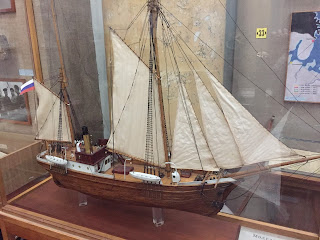39. Museum of the Arctic and Antarctic
I've visited several museums in St. Petersburg that were located in palaces (e.g., the Faberge Museum) but this was the first that was a former church. I'm guessing it was probably decommissioned from its original purpose following the Russian revolution, like so many others, but didn't read this anywhere so cannot say for sure. The main floor focused on Russia's exploration of the Arctic, and up three flights of stairs via the towers at either side of the building to the top floor were exhibits related to Antarctic exploration (much more international in character, but told from the perspective of Russia's involvement). There were a variety of paintings displayed that set a nice mood for the museum - some traditional framed canvases, as well as numerous murals painted directly onto the available nooks and crannies of the church walls and ceilings.
Most of the Arctic exploration exhibits and dioramas were constructed in the 1930s. The Antarctic exhibits were more recent, dating to the 1970s or 1980s. I enjoyed the full-size dioramas that showed different living structures used by Russian explorers, as well as the miniature scenes that featured landscapes of different Arctic islands and settlements. One of my favorite exhibits was a display case that contained the tools a Russian Antarctic explorer used to perform surgery after a bout of appendicitis (complete with a mid-operation photograph).
Museological theory as well as exhibition and interpretation techniques have advanced significantly in the last 80 years, but it's undeniable that there's a certain charm to well-made dioramas from the early twentieth century. The museum could be brought into the twenty-first century with some targeted improvements - Perhaps a few interactive exhibits here or there, or a computer touch screen to better engage visitors with their archival document and photography collections. Although, maps and model ships are timeless and I imagine tweens or teenagers would be fascinated by this museum. Almost the entire museum was Russian-language only, but I didn't find that to be a deterrent to learning. It's pretty easy to look at dioramas, model ships, detailed maps, and display cases full of artifacts and clothing and be able to figure out what's going on. Although the institution is dated, I enjoyed my visit and learned quite a bit about Russian Arctic exploration from the late nineteenth to mid-twentieth centuries.
Most of the Arctic exploration exhibits and dioramas were constructed in the 1930s. The Antarctic exhibits were more recent, dating to the 1970s or 1980s. I enjoyed the full-size dioramas that showed different living structures used by Russian explorers, as well as the miniature scenes that featured landscapes of different Arctic islands and settlements. One of my favorite exhibits was a display case that contained the tools a Russian Antarctic explorer used to perform surgery after a bout of appendicitis (complete with a mid-operation photograph).
Museological theory as well as exhibition and interpretation techniques have advanced significantly in the last 80 years, but it's undeniable that there's a certain charm to well-made dioramas from the early twentieth century. The museum could be brought into the twenty-first century with some targeted improvements - Perhaps a few interactive exhibits here or there, or a computer touch screen to better engage visitors with their archival document and photography collections. Although, maps and model ships are timeless and I imagine tweens or teenagers would be fascinated by this museum. Almost the entire museum was Russian-language only, but I didn't find that to be a deterrent to learning. It's pretty easy to look at dioramas, model ships, detailed maps, and display cases full of artifacts and clothing and be able to figure out what's going on. Although the institution is dated, I enjoyed my visit and learned quite a bit about Russian Arctic exploration from the late nineteenth to mid-twentieth centuries.






































Comments
Post a Comment